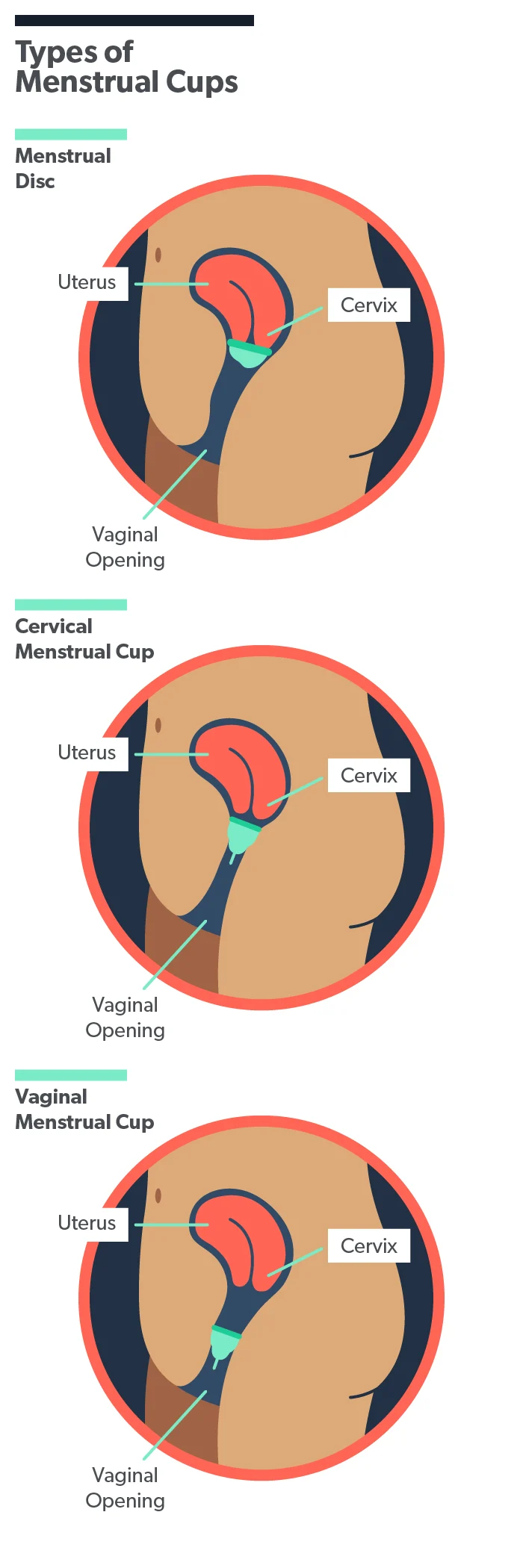Here's what we'll cover
Here's what we'll cover
Here's what we'll cover
There’s a lot of contradictory information out there about having sex while using a menstrual cup or disc. Many people worry that it may be unsafe or uncomfortable, but there are some benefits to having sex with a menstrual cup. Keep reading to learn more.
Can you have sex with a menstrual cup?
Yes, you can—if it’s the right kind of cup. There are two main types of menstrual cups:
The first type, the vaginal cup, is designed to sit lower in the vaginal canal, below your cervix, like a tampon. This type probably isn’t going to work for penetrative sex—it’s going to get a little too crowded in there.
The second type of menstrual cup, the cervical cup, is designed to sit farther up the vaginal canal, cupping the cervix. The back rim of the cup goes below and past the cervix, while the front rim fits behind the pelvic bone.
There’s one other thing to know about cervical cups. Some come with a little stem or handle on the bottom to make removal easier. This isn’t great for sex, as the guy’s member may bump up uncomfortably against the stem. Fortunately, some cup makers have thoughtfully considered this problem and designed cervical cups with smooth bottoms without stems. This is the type of cup you’re looking for if you want to have sex using a menstrual cup.
Both vaginal and cervical cups are small, flexible cups that get inserted into the vagina to collect menstrual blood (a good alternative to tampons, pads, or period panties). Menstrual cups are usually made from medical-grade silicone, but they can also be made with rubber, latex, or elastomer. They can provide up to 12 hours of coverage, depending on whether there’s light or heavy flow (Van Eijk, 2019).
What about sex with a menstrual disc?
A menstrual disc is inserted into the vagina and collects menstrual blood like a menstrual cup. But menstrual discs are flatter and resemble contraceptive diaphragms. They fit into the back of the vaginal canal, where the vagina meets the cervix. Because of this, menstrual discs are well suited for penetrative sex. Neither the woman nor the man should feel it (there may be some exceptions). However, a round of especially enthusiastic sex might shift the disc, and there could be some leakage.
Most menstrual discs are made of plastic and are disposable. When it’s time to remove it, you empty the contents and throw the disc away.

Is it safe to have sex wearing a menstrual cup or disc?
Although there’s a lack of good studies on this subject, there’s no medical reason you shouldn’t have sex while using a menstrual cup or disc.
A large-scale review and analysis published in the well-respected medical journal The Lancet found that menstrual cups are, in general, a safe option for menstruation management. Another good thing: The authors noted that because menstrual cups are reusable, they may be an affordable alternative to costly tampons, pads, and labor-intensive menstrual cloths. This could be important for many girls in developing countries, who may miss school during their periods due to a lack of affordable period products and fall behind in their studies (Van Eijk, 2019).
Benefits of having sex with a menstrual cup or disc
There are several advantages to using a menstrual cup or disc when you have sex during the menstrual period.
No mess—The most obvious advantage to using a cup or disc during sex is there won’t be any period blood mess—no stained sheets or towels to clean up afterward.
Oral sex friendly—If a partner is uncomfortable with the idea of performing oral sex during a woman’s menstrual period, menstrual cups and discs will keep period blood safely dammed up.
No dry vaginas—Unlike tampons, which soak up vaginal juices, menstrual cups and discs let those naturally lubricating vaginal fluids run free.
And, if you use a reusable menstrual cup, you’ll be helping the environment by not adding to the waste stream.
Is it comfortable to wear a menstrual cup or disc during sex?
If the cup or disc is properly inserted and in place, it should be comfortable to have sex while using it. Of course, every woman has her own levels of sensitivity and comfort. The only way to find out if it’s comfortable for you is to give it a try, and you may need to try different types and brands of menstrual cups or discs before you find one that works for you.
Can a guy feel a menstrual cup?
It’s quite possible for a guy not to feel a cup at all. Because the vagina lengthens quite a bit when aroused, the cup will be farther up the vaginal canal than it normally is. When it’s so deep, it’s less likely to be noticed by the male partner.
Whether the guy feels it also depends in part on your sex position. For instance, the guy might not be aware of the cup when doing it in missionary position, but he may feel it when having sex from behind, doggy-style.
Using a softer, more flexible cup will generally make for a more pleasant experience for the guy than using a more rigid cup.
Does using a menstrual cup or disc prevent pregnancy?
No, a menstrual cup or disc won’t prevent pregnancy. Menstrual cups and discs don’t block the passage of sperm into the uterus.
There’s a small but real chance of getting pregnant if you have sex during your period. That’s because sperm can stay alive inside a woman’s reproductive tract for up to five days. If ovulation—the time when a woman is most likely to get pregnant—happens soon after the menstrual period, the sperm could still be living in the reproductive tract and capable of fertilizing the egg (Verma, 2017; Informed Health, 2016).
So if you don’t want to get pregnant, be sure to use a reliable form of contraception, just as you would at any other time of the month.
DISCLAIMER
If you have any medical questions or concerns, please talk to your healthcare provider. The articles on Health Guide are underpinned by peer-reviewed research and information drawn from medical societies and governmental agencies. However, they are not a substitute for professional medical advice, diagnosis, or treatment.
References
InformedHealth.org. (2009). How does the menstrual cycle work? [Updated Aug 10, 2016]. Institute for Quality and Efficiency in Health Care (IQWiG) . Retrieved on Jan. 21, 2022 from https://www.ncbi.nlm.nih.gov/books/NBK279270/
van Eijk, A. M., Zulaika, G., Lenchner, M., Mason, L., Sivakami, M., Nyothach, E., et al. (2019). Menstrual cup use, leakage, acceptability, safety, and availability: a systematic review and meta-analysis. Lancet Public Health , 4 (8), e376–e393. doi: 10.1016/S2468-2667(19)30111-2. Retrieved from https://pubmed.ncbi.nlm.nih.gov/31324419/
Verma, P., Singh, K. K., & Singh, A. (2017). Pregnancy risk during menstrual cycle: misconceptions among urban men in India. Reproductive Health , 14 (1), 71. doi: 10.1186/s12978-017-0332-3. Retrieved from https://www.ncbi.nlm.nih.gov/pmc/articles/PMC5469003/












